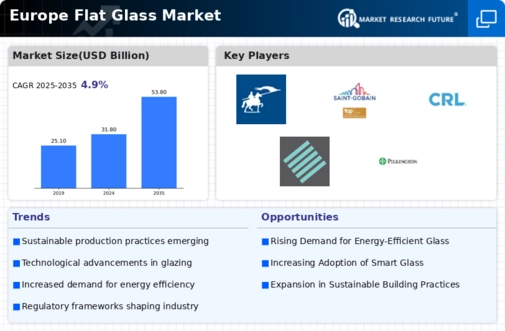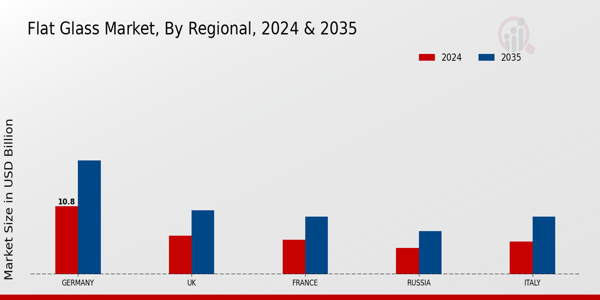The Europe Flat Glass Market is currently experiencing significant trends that are being driven by the growing demand for sustainable construction practices and energy-efficient buildings. The utilization of flat glass in architecture has increased as a result of the European Union's stringent regulations, which are designed to reduce carbon emissions. This has led to improved thermal insulation and energy-efficient design. This encourages manufacturers to develop low-emissivity and solar-control glazing that adheres to these emerging environmental standards.
The construction industry, a significant consumer of flat glass in Europe, is increasingly incorporating advanced glazing solutions that provide functional benefits, including sound insulation and safety, while also enhancing aesthetic appeal. The increasing preference for smart glass technologies, which enable the dynamic modulation of light and heat entering buildings, presents opportunities that are consistent with Europe's dedication to sustainability. Furthermore, the substantial market opportunity for flat glass is presented by the increasing number of renovation and refurbishment projects in major European cities, as older structures are modernized and energy efficiency is enhanced.
Additionally, there is a notable trend in the automotive sector toward the use of flat glass, as improvements in safety standards and design are driving the demand for higher-quality glass products. In Europe, there has been a consistent transition to the circular economy and recycling in recent years. Companies are increasingly investing in technologies that encourage the reuse of glass and reduce waste, which is consistent with the EU's Green Deal initiatives, which are designed to promote sustainability.
The trend of incorporating digital technologies into production processes, such as automation and artificial intelligence, is also emerging, allowing manufacturers to address changing consumer preferences and increase productivity effectively. The pivotal role of flat glass in Europe's transition toward a more sustainable and energy-efficient future is underscored by the ongoing evolution of these trends.
The Europe Flat Glass Market is witnessing pivotal trends driven by the increasing demand for energy-efficient buildings and sustainable construction practices. Stringent regulations aimed at reducing carbon emissions in the European Union have prompted a surge in the usage of flat glass in architecture, promoting better thermal insulation and energy conservation. This pushes manufacturers to innovate and produce low-emissivity and solar control glazing that meet these emerging environmental standards.
The construction industry, which is a key consumer of flat glass in Europe, is increasingly adopting advanced glazing solutions that enhance aesthetic appeal while offering functional benefits such as sound insulation and safety. Opportunities exist in the growing preference for smart glass technologies, which allow for the dynamic adjustment of light and heat entering buildings, aligning with Europe’s commitment to sustainability. Additionally, the rise in renovation and refurbishment projects across major cities in Europe offers a significant market opportunity for flat glass, as older buildings are upgraded to improve energy efficiency and modernize aesthetics.
Furthermore, the trend towards using flat glass in the automotive sector is also notable, where advancements in design and safety standards are driving demand for higher quality glass products. In recent times, trends reflect a steady shift towards recycling and the circular economy in Europe. Companies are increasingly investing in technologies that promote the reuse of glass and reduce waste, aligning with the EU's Green Deal initiatives aimed at promoting sustainability.
The integration of digital technologies in production processes, such as automation and artificial intelligence, is also emerging as a trend, enabling manufacturers to enhance productivity and address changing consumer preferences effectively. As these trends continue to evolve, they underscore the pivotal role of flat glass in Europe's transition towards a more sustainable and energy-efficient future.
















